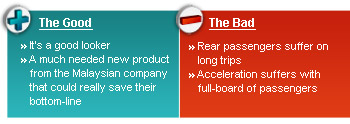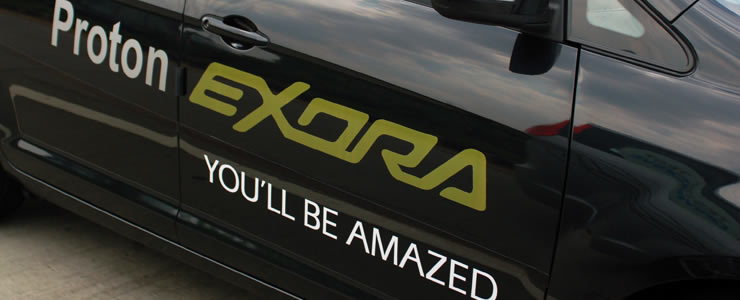Jakarta Car Review - Proton Exora 1.6 (A)
05 Aug 2009|31,865 views
 |
Obvious that they lacked the skills and technological expertise vital in producing a modern automobile, Proton enlisted the help of Mitsubishi Motors who obliged in educating the employees of Proton and providing the Malaysian brand with their mechanical parts.
To summarize the rest of the time-line, Proton came up with the Saga, then the Wira and the Perdana. Acquiring Lotus technologies in 1996, sales figures for the Satria GTi skyrocketed and the momentum rolled over to the Wira's replacement in the Gen-2.
From single-handedly boasting 60% of Malaysia's vehicle ownership pie in 2002, their market share collapsed to a staggering 30%. Proton said that it was "due to the fact that competitors cut their prices", but rather, it was the decreased protectionism of the brand that came from inking the ASEAN FTA, and the rise of Perodua that dealt Dr Mahathir's brainchild it's inevitable fate.
Why the intro was necessary
Because that's what got the wheels turning in a different direction.
Proton went back to the drawing board, reconstructed their management flow, tightened up their various processes and more importantly, realised that the trick to impressive sales figures is to listen to your customers and keep track of the market trends. For years the MPV (Multi-Purpose Vehicle) market has been a burgeoning one in places like Malaysia, Thailand and especially Indonesia where almost 75% of the vehicle population are filled by these people movers.
All Proton did was to put their ear to the ground.
 |
Exterior
Looking at the Exora, it's easy to point out the similar styling cues it has with the Mazda5. That's especially true when you're looking at it from the side.
The front fascia houses two triangular headlamps with a very clean cluster layout while fog lamps flank the lower section of the bumper. A pronounced crease originating from the sides of the front grill, ala Mazda5, cuts deep between the hood and the headlamps and sweep back, fading gradually under the A-pillars.
On the side, designers slotted in a 'now-popular' speed line that connects the front bumper, two door handles and ending off just before the rear lamps. Running parallel to the window line and having those swollen wheel arches, the Exora gives the impression of a sporty nature even at rest.
One feature worth highlighting at the rear is Proton's first hand at an LED light display. Besides the fact that it looks like a random streak the designers made, it's a nice touch in the current age of full LED headlamps.
Interior
Plain fabric seats greet you as you enter and they don't offer you too much support when going through corners. Comfort on the other hand, it fares better with. The dash keeps everything clean with plastic knobs dividing both driver and passenger while the gauge cluster behind the steering wheel gets a red back-glow, all easy to read.
This is a seven-seater but you've got space for six full-sized adults realistically. Two in front, two at the back and 2 in the middle, although you could squeeze someone smaller in the middle row to make three. Aiding comfort are the side aircon vents that help get that cool air back to the individual rows of the Exora.
The boot's pretty decent and gets even better when you able to fold the third row flat and the second row can be folded flat and to the front. The guys at Proton are quick to point out that when loading large bags into the back, the tail lights are less of a hindrance and thus provides a wider entry point than most of the others in the market.
Sitting in the third row for a half hour drive had got me grimacing with pins and needles running through both my legs, and the fellow journalist sitting next to me shared my sentiments of the seats being too firm for a long distance carrier.
 |
Driving Impressions
The 1.6-litre CAMPRO CPS unit produces a modest 125 hp at 6,500 rpm and that power really doesn't seem to come through when you're trying to overtake especially at highway speeds. It's composure over road imperfections and turns however were good, no surprise since Lotus has been helping Proton along in the manufacturing of their platform and the suspension set-up on their Exora. You get a fair amount of feedback through the steering wheel but I felt the steering would have been spot on if it was a tad bit heavier.
Will the Exora be what gets Proton back on track?
I'm not too sure, for a handful of reasons.
For one, I only had 10 minutes driving Proton's brand new MPV. I could possibly pen a full review for our readers but I don't think it'll be fair to both Proton and to you.
Another reason's that in Indonesia, our test cars were filled with the local grade of fuel, which is in the 80's region, lower than the 92 here. That itself could be a contributing factor in the lackluster performance from the much touted CPS engine.
Here, the Exora's primarily up against the Kia Caren's which has a price almost identical to the Malaysian alternative. It's a tough fight as the Korean has more power, but loses out slightly in the equipment level fight and the looks.
With the stigma surrounding the Malaysian car's (and with it being frighteningly likened to the sentiments of the Chinese cars), the Exora is exactly what the brand needed to inject in their various markets, a breath of fresh air. Whether it's the wind of change though, we'll have to wait and see once we get our hands on it in Singapore.
 |
Obvious that they lacked the skills and technological expertise vital in producing a modern automobile, Proton enlisted the help of Mitsubishi Motors who obliged in educating the employees of Proton and providing the Malaysian brand with their mechanical parts.
To summarize the rest of the time-line, Proton came up with the Saga, then the Wira and the Perdana. Acquiring Lotus technologies in 1996, sales figures for the Satria GTi skyrocketed and the momentum rolled over to the Wira's replacement in the Gen-2.
From single-handedly boasting 60% of Malaysia's vehicle ownership pie in 2002, their market share collapsed to a staggering 30%. Proton said that it was "due to the fact that competitors cut their prices", but rather, it was the decreased protectionism of the brand that came from inking the ASEAN FTA, and the rise of Perodua that dealt Dr Mahathir's brainchild it's inevitable fate.
Why the intro was necessary
Because that's what got the wheels turning in a different direction.
Proton went back to the drawing board, reconstructed their management flow, tightened up their various processes and more importantly, realised that the trick to impressive sales figures is to listen to your customers and keep track of the market trends. For years the MPV (Multi-Purpose Vehicle) market has been a burgeoning one in places like Malaysia, Thailand and especially Indonesia where almost 75% of the vehicle population are filled by these people movers.
All Proton did was to put their ear to the ground.
 |
Exterior
Looking at the Exora, it's easy to point out the similar styling cues it has with the Mazda5. That's especially true when you're looking at it from the side.
The front fascia houses two triangular headlamps with a very clean cluster layout while fog lamps flank the lower section of the bumper. A pronounced crease originating from the sides of the front grill, ala Mazda5, cuts deep between the hood and the headlamps and sweep back, fading gradually under the A-pillars.
On the side, designers slotted in a 'now-popular' speed line that connects the front bumper, two door handles and ending off just before the rear lamps. Running parallel to the window line and having those swollen wheel arches, the Exora gives the impression of a sporty nature even at rest.
One feature worth highlighting at the rear is Proton's first hand at an LED light display. Besides the fact that it looks like a random streak the designers made, it's a nice touch in the current age of full LED headlamps.
Interior
Plain fabric seats greet you as you enter and they don't offer you too much support when going through corners. Comfort on the other hand, it fares better with. The dash keeps everything clean with plastic knobs dividing both driver and passenger while the gauge cluster behind the steering wheel gets a red back-glow, all easy to read.
This is a seven-seater but you've got space for six full-sized adults realistically. Two in front, two at the back and 2 in the middle, although you could squeeze someone smaller in the middle row to make three. Aiding comfort are the side aircon vents that help get that cool air back to the individual rows of the Exora.
The boot's pretty decent and gets even better when you able to fold the third row flat and the second row can be folded flat and to the front. The guys at Proton are quick to point out that when loading large bags into the back, the tail lights are less of a hindrance and thus provides a wider entry point than most of the others in the market.
Sitting in the third row for a half hour drive had got me grimacing with pins and needles running through both my legs, and the fellow journalist sitting next to me shared my sentiments of the seats being too firm for a long distance carrier.
 |
Driving Impressions
The 1.6-litre CAMPRO CPS unit produces a modest 125 hp at 6,500 rpm and that power really doesn't seem to come through when you're trying to overtake especially at highway speeds. It's composure over road imperfections and turns however were good, no surprise since Lotus has been helping Proton along in the manufacturing of their platform and the suspension set-up on their Exora. You get a fair amount of feedback through the steering wheel but I felt the steering would have been spot on if it was a tad bit heavier.
Will the Exora be what gets Proton back on track?
I'm not too sure, for a handful of reasons.
For one, I only had 10 minutes driving Proton's brand new MPV. I could possibly pen a full review for our readers but I don't think it'll be fair to both Proton and to you.
Another reason's that in Indonesia, our test cars were filled with the local grade of fuel, which is in the 80's region, lower than the 92 here. That itself could be a contributing factor in the lackluster performance from the much touted CPS engine.
Here, the Exora's primarily up against the Kia Caren's which has a price almost identical to the Malaysian alternative. It's a tough fight as the Korean has more power, but loses out slightly in the equipment level fight and the looks.
With the stigma surrounding the Malaysian car's (and with it being frighteningly likened to the sentiments of the Chinese cars), the Exora is exactly what the brand needed to inject in their various markets, a breath of fresh air. Whether it's the wind of change though, we'll have to wait and see once we get our hands on it in Singapore.
Car Information
Proton Exora Bold 1.6 CPS (A)
CAT A|Petrol|13.5km/L
Horsepower
93kW (125 bhp)
Torque
150 Nm
Acceleration
15.5sec (0-100km /hr)
This model is no longer being sold by local distributor
All Used Proton ExoraThank You For Your Subscription.





























